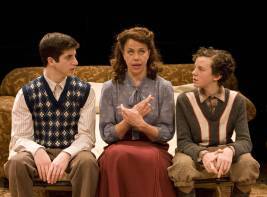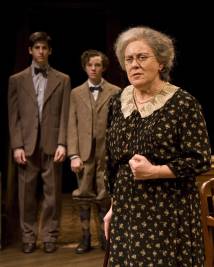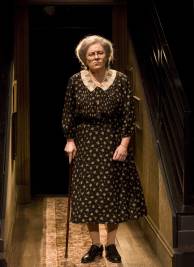
Back when Neil Simon started writing plays like Come Blow Your Horn and Barefoot In The Park for the Broadway stage, few could have imagined that the author of such lightweight fare would go on to one day be awarded the Pulitzer Prize for Drama. Then came Brighton Beach Memoirs and the rest of the “Eugene Trilogy” and critics were forced to admit that Simon was a playwright of unique, remarkable gifts. His 1991 masterwork Lost In Yonkers impressed audiences and reviewers alike and from that play forward Simon would forever be referred to as Pulitzer Prize Winner Neil Simon.
Lost In Yonkers has gone on to become a regional and community theater favorite. I’ve seen it on the big proscenium stage, in 99-seat venues, and now, with The Old Globe’s superb, almost-twentieth anniversary revival, in the round. I’ve seen it performed by unknowns. I’ve seen it performed by veteran actors. The Old Globe production has allowed me to experience the Simon magic as interpreted by Tony Award Winner Judy Kaye in the role of Grandma Kurnitz, and the result is the very best Lost In Yonkers I’ve had the pleasure to see.
Most StageSceneLA readers are doubtless aware of Lost In Yonkers’ plot, which recounts the ten eventful months young Jay and Artie spend with ditzy Aunt Bella and their German-Jewish “grandmother from hell.” The year is 1942, the world is at war, and the brothers have recently suffered the loss of their mother to cancer, an illness which has left their dad, Eddie, severely in debt to a rapacious loan shark. Dad’s solution (to head south and earn enough money to pay off his debts) means leaving his two teens behind with Grandma The Hun.
Grandma Kurnitz suffered a foot injury as a child and since then has walked with a multi-purpose cane, just right for administering punishment to a disobedient child. Reveals Jay, “Pop said she could swing her cane so fast, she could have been one of the greatest golfers in the world.” Oldest son Louie works as “some big mobster’s henchman,” which Artie at first confuses with “hunchback” until Jay corrects him. Daughter Gert has a unique speech defect; she says the first half of every sentence breathing out and the second half sucking the air back in. (“I once saw her try to blow out a candle,” says Jay. “Halfway there she sucked it back on.”) Finally, there’s Bella, whom Jay describes as “a little closed for repairs.” When Artie wonders about Aunt Bella’s education level, Jay informs him that she did go to high school … a little, but “she missed the first year because she couldn’t find it.”
Lost In Yonkers adroitly balances a trio of plots—Jay and Artie’s attempt to survive a year with “Frankenstein’s Grandma,” Bella’s wish to marry a movie usher named Johnny (contingent on getting her mother to give her $5000 so that Johnny can open a restaurant), and the surprise visit of Uncle Louie on the lam from the mob.
For those expecting Simon’s trademark one-liners, there are many of those. When Arty asks Bella what movie she’s just seen, she replies, “I don’t know. I couldn’t find the theater I was looking for, so I went to the one I found.” Later, the preteen asks his aunt if it’s true that Grandma is partly deaf. Bella’s response? “Oh sure. But the other part hears perfectly.”
What sets Lost In Yonkers apart from the rest of the Neil Simon oeuvre is its cast of characters, including arguably the two most complex and multilayered women the master playwright has ever created: Grandma Kurnitz and Bella. Add to that a pair of very real adolescents, a father who would sacrifice pretty much everything for his family, a low-level gangster uncle, and an aunt with a speech impediment slash emotional scar and you’ve got seven of the best Simon characters you’ll likely ever see on stage at once.
Both Bella and Grandma are tough nuts for an actor to crack. The danger is to make Bella too “comedy dumb” and Grandma too “one note.” Jennifer Regan and Broadway star Kaye not only avoid these pitfalls. They give the two finest performances I’ve yet seen in these challenging roles.
Regan’s Bella is so bubbling with childlike enthusiasm and energy that she virtually bounces and jumps around the stage. She may be one taco short of a combination plate (or maybe even two), but she’s no dummy where human relationships are concerned, and much of the joy of Regan’s performance is seeing those sparks of intelligence and wisdom shine through. In Regan’s gifted hands, Bella’s joys are a joy to behold and her disappointments heartbreaking. When Bella finally stands up to her terror of a mother, you believe it because Regan has already given you glimpses of her inner moxie, and the actress’s performance is reason enough to catch this production.
But there’s more, in the person of the magnificent Miss Kaye. Abandoning all vanity as she disappears into Grandma’s barbed-wire gray-haired frumpiness, Kaye gives the most three dimensional performance I’ve yet seen in the role. She’s scary as all get-out at first sight, or rather at first sound, since the thump thump thump of her cane precedes her wherever she goes. No matter how cold and unfeeling Grandma may appear to be, Kaye’s eyes speak volumes of long-buried pain, and as cruel as she may seem, Kaye makes us understand that Grandma truly believes that what she does is for the good of her family. Two pivotal moments late in Act Two have never been as powerful as they are in Kaye’s extraordinary performance.
Steven Kaplan is simply marvelous as older brother Jay, and Austyn Myers (repeating the role he played in La Mirada last year) milks every great Arty moment like the young pro he is. Jeffrey M. Bender, who played to perfection a woman and a hunchback in The Old Globe’s The Mystery Of Irma Vep last year, here gets to add another great characterization to his repertoire as mob henchman Uncle Louie. Amanda Naughton gets many laughs as sweet Aunt Gert, and Spencer Rowe is paternal love personified as the boys’ father Eddie. (Lucky Lowe gets much more stage time than usual, too. Read on to find out why.)
Director Scott Schwartz understands these people well, and working with his masterful team of performers, gets overall the most believable performances I’ve yet seen in the play.
The in-the-round staging is a bit of a mixed bag,. On the plus side, it makes seeing this Lost In Yonkers a much more “up close and personal” experience than it would be in a proscenium theater with the same number of seats. Schwartz moves the actors around the stage unobtrusively, yet in a way that mostly insures that no audience member is shortchanged. But there are scenes where this proves impossible and the production suffers a bit for it. I was seated behind the sofa, thereby missing the facial reactions of anyone seated there, particularly noticeable in an early scene where all I could see was the back of Bella’s head. A dramatic confrontation between Bella and Grandma in Act Two had both Regan and Kaye facing me, thereby denying almost half the audience the full effect of the scene. The fault is not Schwartz’s but the in-the-round setup. On the other hand, we now get to see rather than just hear Eddie as he reads the letters he has written to his boys from the four corners of the U.S. (and, standing in the aisles, from the four corners of the Sheryl and Harvey White Theatre).
Ralph Funicello’s set design features just the furniture one would expect to find in a 1940s Yonkers apartment, and a nice window effect visible before each act begins. Alejo Vietti’s costumes are precisely what each character would wear, circa 1942. Kudos too to Matthew McCarthy’s lighting and Paul Peterson’s sound design. (I loved the dramatic opening music and radio war reports.)
My guest on Sunday was discovering Lost In Yonkers for the first time and fell in love with the production (and Simon’s play) from the get-go. I felt exactly the same as a seasoned Lost In Yonkers devotee. A word of warning to any future productions of Lost In Yonkers. You’ve got a tough act to follow.
The Old Globe Sheryl and Harvey White Theatre, Balboa Park, 1363 Old Globe Way, San Diego.
www.theoldglobe.org
–Steven Stanley
January 31, 2010
Photos: Craig Schwartz





 Since 2007, Steven Stanley's StageSceneLA.com has spotlighted the best in Southern California theater via reviews, interviews, and its annual StageSceneLA Scenies.
Since 2007, Steven Stanley's StageSceneLA.com has spotlighted the best in Southern California theater via reviews, interviews, and its annual StageSceneLA Scenies.







 COPYRIGHT 2024 STEVEN STANLEY :: DESIGN BY
COPYRIGHT 2024 STEVEN STANLEY :: DESIGN BY